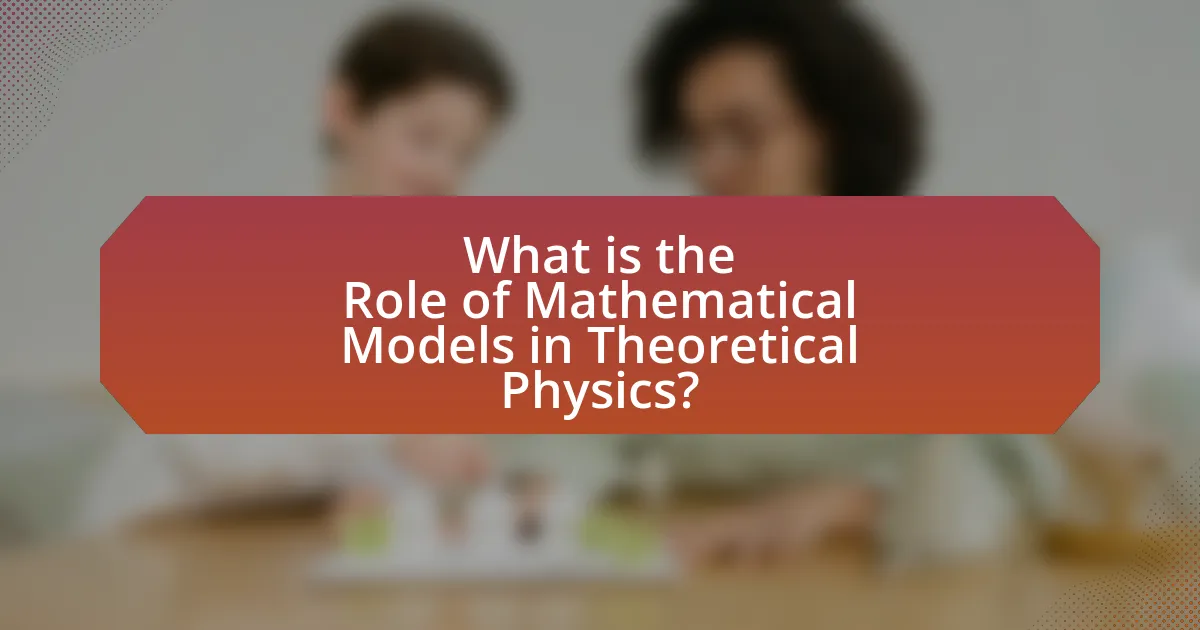Mathematical models are fundamental tools in theoretical physics, providing a structured framework to describe and predict physical phenomena. They translate complex physical concepts into mathematical language, enabling physicists to formulate theories and derive equations that accurately represent system behaviors. The article explores the role of mathematical models in enhancing our understanding of physical phenomena, their key characteristics, and the various types used in the field, such as deterministic and stochastic models. Additionally, it addresses the challenges faced in modeling, the importance of empirical data for validation, and best practices for developing effective models, emphasizing the significance of interdisciplinary approaches in advancing theoretical physics.

What is the Role of Mathematical Models in Theoretical Physics?
Mathematical models serve as essential tools in theoretical physics by providing a framework to describe and predict physical phenomena. These models translate complex physical concepts into mathematical language, enabling physicists to formulate theories and derive equations that represent the behavior of systems. For instance, the equations of motion in classical mechanics, derived from Newton’s laws, exemplify how mathematical models can predict the trajectory of objects under various forces. Additionally, models such as quantum mechanics utilize mathematical structures like wave functions to describe the probabilistic nature of particles. The success of these models is evidenced by their ability to make accurate predictions, such as the behavior of electrons in atoms, which have been confirmed through experiments. Thus, mathematical models are fundamental in bridging abstract theoretical concepts with empirical observations in physics.
How do mathematical models contribute to our understanding of physical phenomena?
Mathematical models significantly enhance our understanding of physical phenomena by providing a structured framework to describe, predict, and analyze complex systems. These models translate physical laws into mathematical language, allowing for precise calculations and simulations. For instance, Newton’s laws of motion, expressed mathematically, enable the prediction of an object’s trajectory under various forces, which has been validated through countless experiments and applications in engineering and space exploration. Furthermore, mathematical models facilitate the exploration of theoretical concepts, such as quantum mechanics and relativity, by allowing scientists to derive implications and test hypotheses against empirical data. The success of these models in accurately describing phenomena, such as the behavior of particles at high energies in particle physics, underscores their critical role in advancing our comprehension of the universe.
What are the key characteristics of effective mathematical models in physics?
Effective mathematical models in physics are characterized by their ability to accurately represent physical phenomena, predict outcomes, and provide insights into underlying principles. These models must be based on fundamental physical laws, such as Newton’s laws of motion or the laws of thermodynamics, ensuring they are grounded in established scientific theory. Additionally, effective models should be both simple and flexible, allowing for easy adaptation to various scenarios while maintaining accuracy.
For instance, the ideal gas law is a mathematical model that simplifies the behavior of gases under certain conditions, demonstrating how effective models can encapsulate complex behaviors in a manageable form. Furthermore, successful models often incorporate empirical data to validate their predictions, as seen in the use of statistical mechanics to describe thermodynamic systems. This reliance on empirical evidence reinforces the model’s credibility and applicability in real-world situations.
How do mathematical models simplify complex physical systems?
Mathematical models simplify complex physical systems by providing a structured framework to represent and analyze the underlying principles governing those systems. These models use equations and algorithms to distill intricate interactions into manageable forms, allowing for predictions and insights that would be difficult to achieve through direct observation alone. For instance, Newton’s laws of motion mathematically describe the behavior of objects under various forces, enabling the prediction of their trajectories without needing to observe every detail of their movement. This abstraction is crucial in fields like fluid dynamics, where the Navier-Stokes equations encapsulate the behavior of fluid flow, simplifying the analysis of turbulent systems. Thus, mathematical models serve as essential tools in theoretical physics, transforming complex phenomena into comprehensible and solvable problems.
Why are mathematical models essential in theoretical physics?
Mathematical models are essential in theoretical physics because they provide a precise framework for describing physical phenomena and predicting outcomes. These models allow physicists to translate complex real-world situations into mathematical language, enabling them to analyze and solve problems systematically. For instance, the equations of motion in classical mechanics, derived from Newton’s laws, illustrate how mathematical formulations can predict the behavior of objects under various forces. Additionally, models such as quantum mechanics and general relativity have revolutionized our understanding of the universe, demonstrating that mathematical structures can encapsulate fundamental principles governing reality. The success of these models is evidenced by their ability to yield accurate predictions that have been experimentally validated, such as the prediction of gravitational waves by general relativity, which were confirmed by direct observation in 2015.
What role do they play in formulating theories and predictions?
Mathematical models play a crucial role in formulating theories and predictions in theoretical physics by providing a structured framework to describe physical phenomena quantitatively. These models allow physicists to translate complex concepts into mathematical language, enabling them to derive predictions that can be tested through experiments. For instance, Einstein’s equations of general relativity mathematically describe the gravitational interactions of massive bodies, leading to predictions such as the bending of light around stars, which was confirmed during a solar eclipse in 1919. This demonstrates how mathematical models not only facilitate theoretical development but also validate theories through empirical evidence.
How do mathematical models facilitate communication among physicists?
Mathematical models facilitate communication among physicists by providing a standardized language that conveys complex concepts and relationships succinctly. These models allow physicists to express theories, predictions, and experimental results in a precise manner, enabling clear understanding and collaboration across diverse subfields. For instance, the use of equations like Einstein’s field equations in general relativity allows physicists to discuss gravitational phenomena universally, regardless of their specific area of expertise. This shared mathematical framework enhances the ability to compare results, validate theories, and develop new insights collectively, thereby advancing the field of theoretical physics.

What types of mathematical models are used in theoretical physics?
The types of mathematical models used in theoretical physics include differential equations, statistical models, and geometric models. Differential equations, such as the Schrödinger equation in quantum mechanics, describe how physical systems evolve over time. Statistical models, like those used in thermodynamics, analyze systems with many particles and predict macroscopic properties from microscopic behavior. Geometric models, such as those in general relativity, utilize the curvature of spacetime to explain gravitational phenomena. These models are foundational in theoretical physics, providing frameworks for understanding complex physical realities and enabling predictions that can be tested experimentally.
What are the main categories of mathematical models in physics?
The main categories of mathematical models in physics are deterministic models, stochastic models, and empirical models. Deterministic models predict a single outcome based on initial conditions and governing equations, such as Newton’s laws of motion. Stochastic models incorporate randomness and uncertainty, often used in statistical mechanics and quantum mechanics, where outcomes can vary even with the same initial conditions. Empirical models rely on observed data to formulate relationships, commonly seen in thermodynamics and material science, where experimental data informs theoretical frameworks. These categories are essential for understanding and predicting physical phenomena across various domains in physics.
How do deterministic models differ from stochastic models?
Deterministic models produce consistent outcomes from given initial conditions, while stochastic models incorporate randomness, leading to different possible outcomes even with the same initial conditions. In deterministic models, such as Newton’s laws of motion, the future state of a system can be precisely predicted if the current state is known. In contrast, stochastic models, like those used in quantum mechanics or financial markets, account for uncertainty and variability, making predictions probabilistic rather than certain. This fundamental difference highlights how deterministic models rely on fixed relationships, whereas stochastic models embrace inherent unpredictability in complex systems.
What is the significance of numerical models in theoretical physics?
Numerical models are significant in theoretical physics as they enable the simulation and analysis of complex physical systems that are analytically intractable. These models allow physicists to explore phenomena such as fluid dynamics, quantum mechanics, and cosmology by providing approximate solutions to mathematical equations that describe these systems. For instance, numerical simulations have been crucial in understanding the behavior of turbulent flows, where traditional analytical methods fail. The use of high-performance computing has further enhanced the capability to model intricate interactions in many-body systems, leading to breakthroughs in fields like condensed matter physics and astrophysics.
How are mathematical models validated in theoretical physics?
Mathematical models in theoretical physics are validated through a combination of empirical testing, consistency with established theories, and predictive accuracy. Empirical testing involves comparing model predictions with experimental data; for instance, the predictions of quantum mechanics have been validated through numerous experiments, such as the double-slit experiment, which confirms wave-particle duality. Consistency with established theories ensures that new models do not contradict well-validated frameworks, such as general relativity or the Standard Model of particle physics. Predictive accuracy is assessed by how well a model can forecast new phenomena; for example, the Higgs boson was predicted by the Standard Model before its discovery at CERN in 2012, providing strong validation for the model.
What methods are used to test the accuracy of mathematical models?
Mathematical models are tested for accuracy using methods such as validation against empirical data, sensitivity analysis, and cross-validation. Validation against empirical data involves comparing model predictions with observed measurements to assess how well the model represents real-world phenomena. Sensitivity analysis examines how variations in model inputs affect outputs, helping to identify which parameters are most influential on model accuracy. Cross-validation involves partitioning data into subsets to train the model on one subset and test it on another, ensuring that the model generalizes well to unseen data. These methods are essential in fields like theoretical physics, where precise predictions are critical for understanding complex systems.
How does empirical data influence the refinement of models?
Empirical data significantly influences the refinement of models by providing real-world evidence that can validate or challenge theoretical predictions. When models are developed, they often rely on assumptions and simplifications; empirical data allows researchers to assess the accuracy of these models against observed phenomena. For instance, in theoretical physics, the predictions of models such as the Standard Model of particle physics have been refined through experimental data from particle accelerators like the Large Hadron Collider, which confirmed the existence of the Higgs boson in 2012. This empirical validation led to adjustments in the model to better align with observed behaviors, demonstrating how data-driven insights can enhance theoretical frameworks.

What challenges do physicists face when using mathematical models?
Physicists face several challenges when using mathematical models, primarily related to the complexity of accurately representing physical phenomena. One significant challenge is the simplification of real-world systems, which often leads to models that cannot capture all relevant variables or interactions, resulting in predictions that may not align with experimental data. For instance, in quantum mechanics, the mathematical models can become highly abstract and difficult to interpret, complicating the connection between theory and observable outcomes. Additionally, the computational limitations in solving complex equations can hinder the ability to analyze systems effectively, as seen in simulations of turbulent fluid dynamics, where the equations involved are notoriously difficult to solve. These challenges highlight the ongoing need for refinement in mathematical modeling techniques to enhance their applicability and accuracy in theoretical physics.
What limitations do mathematical models have in representing reality?
Mathematical models have significant limitations in representing reality, primarily due to their reliance on simplifications and assumptions. These models often abstract complex systems, omitting critical variables and interactions that influence real-world behavior. For instance, in climate modeling, factors such as human behavior and unforeseen natural events are difficult to quantify, leading to potential inaccuracies in predictions. Additionally, mathematical models may not account for non-linear dynamics, which are prevalent in many natural systems, resulting in a gap between model predictions and actual outcomes. This limitation is evident in the field of economics, where models frequently fail to predict market crashes due to their inability to incorporate irrational human behavior. Thus, while mathematical models serve as valuable tools for understanding phenomena, their effectiveness is constrained by the inherent complexities of the systems they aim to represent.
How do approximations affect the reliability of models?
Approximations can significantly reduce the reliability of models by introducing errors that deviate from actual phenomena. In theoretical physics, models often rely on simplifications to make complex systems more tractable; however, these simplifications can lead to inaccuracies. For instance, the use of linear approximations in non-linear systems can result in predictions that diverge from observed behavior, as seen in the limitations of perturbation theory in quantum mechanics. Empirical studies, such as those examining the accuracy of climate models, demonstrate that approximations can lead to substantial variances in predicted outcomes, underscoring the importance of carefully assessing the impact of these approximations on model reliability.
What are the consequences of oversimplification in mathematical modeling?
Oversimplification in mathematical modeling can lead to inaccurate predictions and misinterpretations of complex systems. When models reduce intricate phenomena to overly simplistic representations, they often fail to capture essential variables and interactions, resulting in flawed conclusions. For instance, in climate modeling, neglecting feedback mechanisms can lead to underestimating the impacts of climate change, as demonstrated by the Intergovernmental Panel on Climate Change (IPCC) reports, which emphasize the importance of incorporating complex interactions for reliable forecasts. Thus, oversimplification undermines the validity of models, potentially leading to misguided decisions in fields such as physics, engineering, and environmental science.
How can physicists overcome challenges in mathematical modeling?
Physicists can overcome challenges in mathematical modeling by employing advanced computational techniques and interdisciplinary collaboration. Advanced computational techniques, such as numerical simulations and machine learning algorithms, allow physicists to analyze complex systems that are difficult to model analytically. For instance, the use of high-performance computing has enabled the simulation of phenomena like turbulence and quantum many-body systems, which are otherwise intractable with traditional methods. Interdisciplinary collaboration with mathematicians and computer scientists enhances the development of innovative modeling approaches, leading to more accurate and efficient solutions. This collaborative effort is exemplified in projects like the Large Hadron Collider, where physicists work alongside data scientists to interpret vast amounts of experimental data through sophisticated models.
What strategies can be employed to improve model accuracy?
To improve model accuracy, one effective strategy is to enhance data quality through rigorous preprocessing and cleaning techniques. High-quality data reduces noise and ensures that the model learns from relevant patterns. For instance, a study by Zhang et al. (2020) in the Journal of Machine Learning Research demonstrated that models trained on well-prepared datasets achieved up to 30% higher accuracy compared to those trained on raw data. Additionally, employing advanced algorithms, such as ensemble methods, can significantly boost performance by combining predictions from multiple models, as shown in research by Dietterich (2000), which indicated that ensemble techniques often outperform single models in various tasks.
How can interdisciplinary approaches enhance mathematical modeling in physics?
Interdisciplinary approaches enhance mathematical modeling in physics by integrating concepts and methodologies from various fields, leading to more robust and comprehensive models. For instance, the application of computational techniques from computer science allows physicists to simulate complex systems that are analytically intractable, such as turbulent fluid dynamics. Additionally, insights from biology can inform models of complex adaptive systems, improving the understanding of phenomena like phase transitions. Research has shown that collaborations between physicists and engineers have led to advancements in materials science, where mathematical models are crucial for predicting material behavior under different conditions. This cross-pollination of ideas not only enriches the modeling process but also fosters innovation, as evidenced by the development of new theoretical frameworks that emerge from such collaborations.
What best practices should be followed when developing mathematical models in theoretical physics?
When developing mathematical models in theoretical physics, it is essential to ensure clarity and precision in the formulation of equations. Clear definitions of variables and parameters facilitate understanding and communication among researchers. Additionally, models should be grounded in established physical principles, such as conservation laws or symmetries, to ensure their validity.
Incorporating empirical data during the modeling process enhances the model’s reliability and predictive power. Regularly validating the model against experimental results is crucial; for instance, the success of the Standard Model of particle physics is largely due to its alignment with experimental findings from particle accelerators.
Furthermore, iterative refinement of models based on feedback and new data is a best practice, as seen in the evolution of cosmological models that adapt to observations from telescopes. Collaboration with interdisciplinary teams can also provide diverse perspectives, improving the robustness of the model.
Lastly, documenting assumptions and limitations transparently allows for better interpretation and future modifications of the model, as demonstrated in the development of string theory, where ongoing debates about its assumptions continue to shape research directions.




